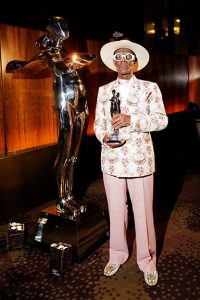
By Deon C. Jefferson
 Hip Hop was born sometime in the late 1970’s. Its origins can be traced to the Bronx, New York and it was brought to the mainstream by African Americans, Jamaicans, and Puerto Ricans. This new musical genre brought a different attitude to music, and it ushered in a new style of dressing. In the 1970’s, brands like Kangol and Adidas were hot commodities in hip hop. The 1980’s brought a whole new flavor. There was one designer that took hip hop fashion to the next level, and he is the “Godfather of Hip-Hop Fashion, ‘’ That man is none other than Dapper Dan. Recently, he won the Geoffrey Beene Lifetime Achievement Award at the CFDA Awards.
Hip Hop was born sometime in the late 1970’s. Its origins can be traced to the Bronx, New York and it was brought to the mainstream by African Americans, Jamaicans, and Puerto Ricans. This new musical genre brought a different attitude to music, and it ushered in a new style of dressing. In the 1970’s, brands like Kangol and Adidas were hot commodities in hip hop. The 1980’s brought a whole new flavor. There was one designer that took hip hop fashion to the next level, and he is the “Godfather of Hip-Hop Fashion, ‘’ That man is none other than Dapper Dan. Recently, he won the Geoffrey Beene Lifetime Achievement Award at the CFDA Awards.
“Receiving the CFDA Lifetime Achievement Award, to me, feels a little different, because my journey has been so long,” said Dapper Dan to Vogue Magazine. “What I’ve been thinking over since they announced that I was going to get this award is that the award could represent two things. One, it could be a recognition for all the work that I’ve put in for the past 35 years that was never acknowledged. It could also be an apology. I’ve seen a lot of people of color who went unrecognized in the past be apologized to now they finally get an award.”
Dapper Dan winning this award not only is a big win for hip hop, but it also solidifies a big win for the African American community. Daniel “Dapper Dan” Day just became the first African American designer to receive this highly respected award. His win also means that he is the first designer to win the award without having an official runway show. By winning this award he joins the likes of other legendary designers like Vera Wang, Calvin Klein, and Giorgio Armani.
Harlem, New York is where the designer and haberdasher was born. Dapper Dan has revealed that he started his career in fashion by selling shoplifted clothes from the back of his car. Next, he opened Dapper Dan’s Boutique which was located on 125th between Madison and Fifth Avenue. The now infamous boutique opened in 1982. Dapper Dan wanted to be a wholesaler, but his peers in the industry that could give him the product would not collaborate with him. The location of the store and his race were the reason wholesalers would not collaborate with him. In the Dapper Dan Boutique, he sold knockoff designs that featured bootlegged fabrics that he created himself. If that’s not enough, he single-handedly invented a new method for screen printing onto leather. This process was something that the major design companies did not tap into.
“When I first opened my store, all the rappers used to come to me,” mentioned Dapper Dan to Vogue Magazine. “Rappers then started taking off. I was the only designer who all the rappers used to wear on Yo! MTV Raps and in all the venues that were available to them at that time. Once the fashion industry discovered how I built this following, they said “if the artists wear anything that is made by Dapper Dan, we will not advertise with you.”
Dapper Dan was a household name in Harlem, the crack cocaine epidemic contributed to his popularity. In 1985 is when he started to design clothing for hip hop artists. As we know it today, Dapper Dan’s designs have been seen on royalty like Eric B. & Rakim, LL Cool J, The Fat Boys, Salt-N-Pepa, KRS-One, Bobby Brown, and Big Daddy Kane just to name a few. Thanks to his genius designs and his illegal use of the major brands logos, his first store was shut down. He experienced several raids and was taken to court by Fendi. The monumental boutique was shut down in 1992. For years, he was seen as a joke from the fashion industry, and he resorted to working as an underground designer.
“Back then, the rappers wanted to be like the gangsters,” said Dapper Dan in a 2019 interview with NPR. “They wanted to dress like the gangsters. Today we have the opposite going on. The gangsters want to be like the rappers. And Eric B and Rakim – those were the first ones that really – gangsters really, really liked their style.”
In recent years, Dapper Dan has seen a resurgence in his career. In 2017, Gucci’s creative director Alessandro Michele paid homage to Dapper Dan’s jacket that he made for athlete Diana Dixon by re-designing the iconic 1989 jacket. Fans of Dapper Dan remember this jacket. It was fur-lined with massive balloon sleeves, also featuring Louis Vuitton fabric. Thanks to the support of Michele and Gucci’s CEO Marco Bizzarri, Dapper Dan collaborated with the brand for a line of menswear. His days of running a boutique came in handy when he opened the first ever fashion luxury house store in Harlem.
Dapper Dan changed the face of what hip hop looked like. Without the influence of Dapper Dan, we would not have the hip hop brands that we have loved in the past like Roca wear, Sean Jean, and Fubu. Hopefully, this will inspire the industry to recognize other vanguards in the hip hop industry.


Be the first to comment